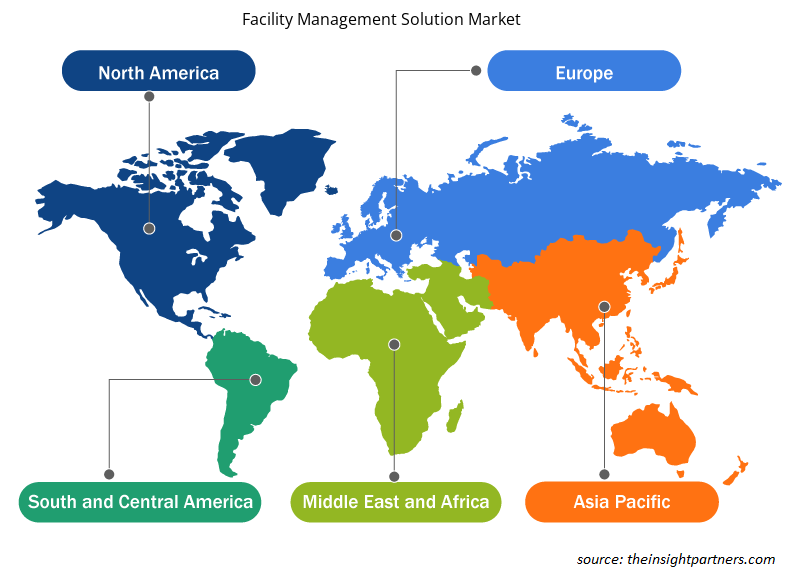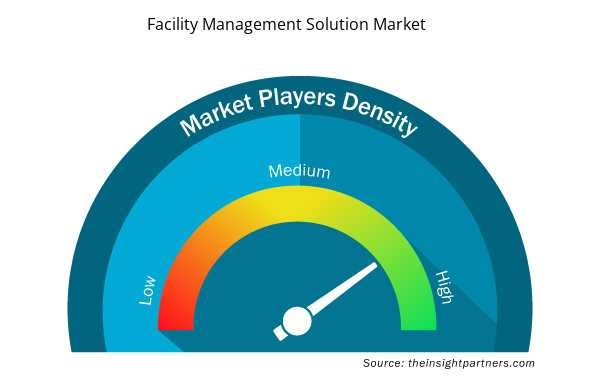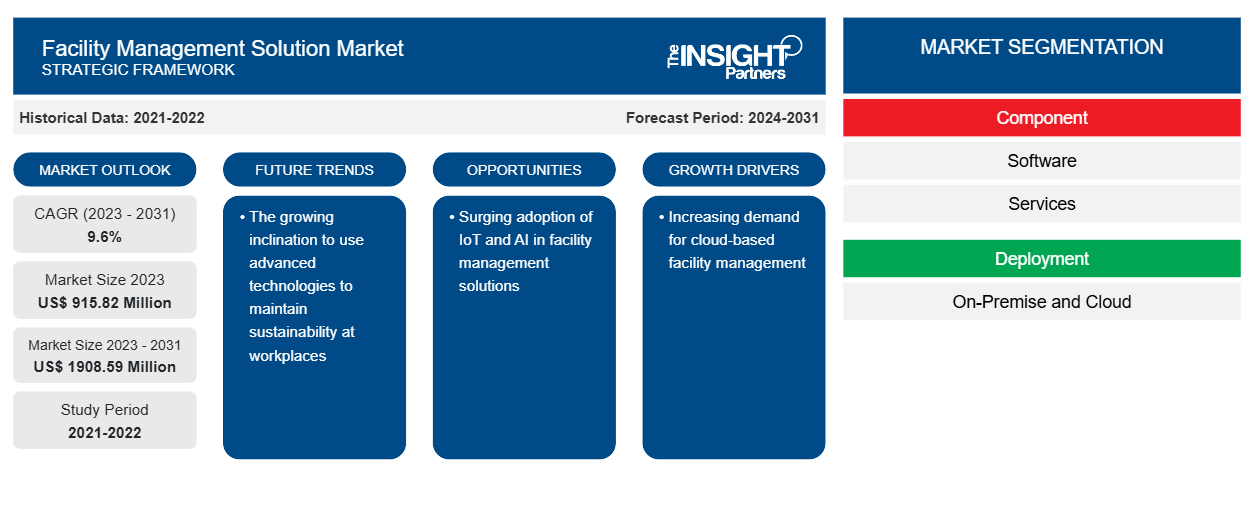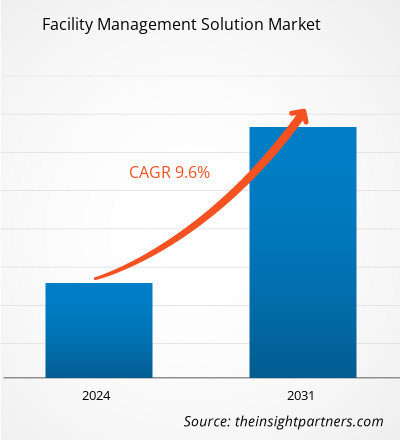Der Markt für Facility-Management-Lösungen soll von 915,82 Millionen US-Dollar im Jahr 2023 auf 1.908,59 Millionen US-Dollar im Jahr 2031 anwachsen. Der Markt wird zwischen 2023 und 2031 voraussichtlich eine durchschnittliche jährliche Wachstumsrate von 9,6 % verzeichnen. Die steigende Nachfrage nach Cloud-basierten Facility-Management-Lösungen und die zunehmende Einführung von IoT und KI in Facility-Management-Lösungen dürften weiterhin die wichtigsten Trends auf dem Markt bleiben.
Marktanalyse für Facility-Management-Lösungen
Die Einführung von Facility-Management-Lösungen führt zu einer Senkung der Arbeits- und Energiekosten. Daher übernehmen zahlreiche Unternehmen und Organisationen in Branchen wie BFSI, Einzelhandel, Transport und Logistik, Pharmazeutika, Regierung, IT und Telekommunikation, Fertigung und anderen diese Lösung, die ihr Marktwachstum weltweit fördert.
Marktübersicht zu Facility-Management-Lösungen
Das Facility Management nutzt Tools und Services, um die betriebliche Effizienz, Sicherheit und ökologische Nachhaltigkeit von Gebäuden, Infrastruktur und Immobilien zu gewährleisten. Die Lösung konzentriert sich auf die Unterstützung von Einzelpersonen und Organisationen, indem sichergestellt wird, dass die gebaute Umwelt, einschließlich der Gebäude und der umgebenden Infrastruktur, optimale Funktionalität, Komfort, Sicherheit, Nachhaltigkeit und Effizienz bietet. Das Hauptziel des Facility Managements besteht darin, Menschen, Orte und Prozesse in die gebaute Umwelt zu integrieren, um die Lebensqualität der Bewohner zu verbessern und die Produktivität der Kerngeschäftsabläufe zu steigern. Organisationen können durch eine effektive Verwaltung von Einrichtungen eine förderliche Umgebung schaffen, die Wohlbefinden, Produktivität und Erfolg fördert.
Passen Sie diesen Bericht Ihren Anforderungen an
Sie erhalten kostenlos individuelle Anpassungen an jedem Bericht, einschließlich Teilen dieses Berichts oder einer Analyse auf Länderebene, eines Excel-Datenpakets sowie tolle Angebote und Rabatte für Start-ups und Universitäten.
- Holen Sie sich die wichtigsten Markttrends aus diesem Bericht.Dieses KOSTENLOSE Beispiel umfasst eine Datenanalyse von Markttrends bis hin zu Schätzungen und Prognosen.
Markttreiber und Chancen für Facility-Management-Lösungen
Wachsende Bauindustrie
Die wachsende Urbanisierung und Bevölkerung sind die Hauptfaktoren, die die kommerziellen, wohnlichen und industriellen Infrastrukturen vorantreiben. Die Vorteile der Digitalisierung in der Baubranche haben die Marktteilnehmer dazu ermutigt, Softwarelösungen einzusetzen, um ihre Geschäftsabläufe und Arbeitsabläufe effizient zu verwalten. Die Einführung von Facility-Management-Lösungen in der Baubranche kann den Marktteilnehmern helfen, die neue Infrastruktur effizient zu warten und zu verwalten. Die Funktionen der Software wie vorbeugende Wartung, Raummanagement und andere können ebenfalls dazu beitragen, die neue Infrastruktur effizient aufzubauen. Somit kann die wachsende Baubranche lukrative Möglichkeiten für den Markt für Facility-Management-Lösungen schaffen.digitalization in the construction industry have encouraged its market players to adopt software solutions to efficiently manage their business operations and workflow. The adoption of facility management solutions in the construction industry can help the market players maintain and manage the new infrastructure efficiently. The features of software such as preventive maintenance, space management, and others can also help to build the new infrastructure efficiently. Thus, the growing construction industry can create lucrative opportunities for the facility management solution market.
Nachfrage nach Cloud-basierten Lösungen.
Die Skalierbarkeit und Flexibilität, die Cloud-Lösungen bieten, führen zur Akzeptanz des Marktes für cloudbasierte Facility-Management-Lösungen. Cloudbasierte, kostengünstige Lösungen helfen Unternehmen bei der Verwaltung ihrer Anlagen und Vermögenswerte. Sie bieten verbesserte Datenverwaltungsfunktionen durch die Zentralisierung von Speicherung und Verwaltung in der Cloud. Verschiedene Marktteilnehmer bieten cloudbasierte Facility-Management-Lösungen an, um der Nachfrage nach cloudbasierten Lösungen gerecht zu werden. QuickFMS bietet beispielsweise cloudbasierte Facility-Management-Software, mit der Unternehmen Wartungsanfragen verwalten und verfolgen, vorbeugende Wartung planen, Lagerbestände verwalten , Vermögenswerte verfolgen, den Energieverbrauch überwachen und vieles mehr können.QuickFMS provides cloud-based facility management software that enables the organization to manage and track maintenance requests, schedule preventive maintenance, manage
Marktbericht zur Facility-Management-Lösung – Segmentierungsanalyse
Wichtige Segmente, die zur Ableitung der Marktanalyse für Facility-Management-Lösungen beigetragen haben, sind Komponente, Bereitstellung, Unternehmensgröße und Anwendung.
- Basierend auf der Komponente ist der Markt für Facility-Management-Lösungen in Software und Dienstleistungen unterteilt. Das Softwaresegment hielt im Jahr 2023 den größten Marktanteil.
- Der Markt ist nach Bereitstellung in On-Premise und Cloud segmentiert. Das Cloud-Segment wird voraussichtlich mit der höchsten durchschnittlichen jährlichen Wachstumsrate wachsen.CAGR.
- Basierend auf der Unternehmensgröße ist der Markt für Facility-Management-Lösungen in Großunternehmen und KMU segmentiert. Das Segment der Großunternehmen dürfte die höchste durchschnittliche jährliche Wachstumsrate aufweisen.SMEs. The large enterprises segment is expected to grow with the highest CAGR.
- Nach Anwendung ist der Markt in BFSI, Einzelhandel, Transport und Logistik, Pharmazeutika, Regierung, IT und Telekommunikation, Fertigung und andere unterteilt. Das IT- und Telekommunikationssegment hielt im Jahr 2023 einen erheblichen Marktanteil.BFSI, retail, transport and logistics, pharmaceuticals, government, IT and telecom, manufacturing, and others. The IT and telecom segment held a significant share of the market in 2023.
Marktanteilsanalyse für Facility-Management-Lösungen nach geografischer Lage
Der geografische Umfang des Marktberichts zu Facility-Management-Lösungen ist hauptsächlich in fünf Regionen unterteilt: Nordamerika, Asien-Pazifik, Europa, Naher Osten und Afrika sowie Süd- und Mittelamerika.
Der asiatisch-pazifische Raum hatte den größten Marktanteil und wird voraussichtlich mit der höchsten durchschnittlichen jährlichen Wachstumsrate wachsen. Die zunehmende Digitalisierung und der Anstieg der Nutzung von Softwarelösungen treiben das Marktwachstum an. Die zunehmende Digitalisierung bei KMU und der Bedarf an effizientem Facility Management sind einige der wichtigsten Antriebsfaktoren des Marktes für Facility-Management-Lösungen.CAGR. The growing digitalization and rise in the adoption of software solutions are driving market growth. The growing digitalization among SMEs and the need for efficient facility management are some of the major driving factors of the facility management solution market.
Regionale Einblicke in den Markt für Facility-Management-Lösungen
Die regionalen Trends und Faktoren, die den Markt für Facility-Management-Lösungen im Prognosezeitraum beeinflussen, wurden von den Analysten von Insight Partners ausführlich erläutert. In diesem Abschnitt werden auch die Marktsegmente und die Geografie von Facility-Management-Lösungen in Nordamerika, Europa, im asiatisch-pazifischen Raum, im Nahen Osten und Afrika sowie in Süd- und Mittelamerika erörtert.

- Erhalten Sie regionale Daten zum Markt für Facility-Management-Lösungen
Umfang des Marktberichts zu Facility-Management-Lösungen
| Berichtsattribut | Details |
|---|---|
| Marktgröße im Jahr 2023 | 915,82 Millionen US-Dollar |
| Marktgröße bis 2031 | 1908,59 Millionen US-Dollar |
| Globale CAGR (2023 - 2031) | 9,6 % |
| Historische Daten | 2021-2022 |
| Prognosezeitraum | 2024–2031 |
| Abgedeckte Segmente | Nach Komponente
|
| Abgedeckte Regionen und Länder | Nordamerika
|
| Marktführer und wichtige Unternehmensprofile |
|
Dichte der Marktteilnehmer für Facility-Management-Lösungen: Die Auswirkungen auf die Geschäftsdynamik verstehen
Der Markt für Facility-Management-Lösungen wächst rasant. Dies wird durch die steigende Nachfrage der Endnutzer aufgrund von Faktoren wie sich entwickelnden Verbraucherpräferenzen, technologischen Fortschritten und einem größeren Bewusstsein für die Vorteile des Produkts vorangetrieben. Mit der steigenden Nachfrage erweitern Unternehmen ihr Angebot, entwickeln Innovationen, um die Bedürfnisse der Verbraucher zu erfüllen, und nutzen neue Trends, was das Marktwachstum weiter ankurbelt.
Die Marktteilnehmerdichte bezieht sich auf die Verteilung der Firmen oder Unternehmen, die in einem bestimmten Markt oder einer bestimmten Branche tätig sind. Sie gibt an, wie viele Wettbewerber (Marktteilnehmer) in einem bestimmten Marktraum im Verhältnis zu seiner Größe oder seinem gesamten Marktwert präsent sind.
Die wichtigsten auf dem Markt für Facility-Management-Lösungen tätigen Unternehmen sind:
- Axonator Inc
- Facilitron, Inc
- FacilityBot Pte Ltd
- FM:Systeme
- Vixxo
- IBM Corporation
Haftungsausschluss : Die oben aufgeführten Unternehmen sind nicht in einer bestimmten Reihenfolge aufgeführt.

- Überblick über die wichtigsten Akteure auf dem Markt für Facility-Management-Lösungen
Neuigkeiten und aktuelle Entwicklungen zum Markt für Facility-Management-Lösungen
Der Markt für Facility-Management-Lösungen wird durch die Erhebung qualitativer und quantitativer Daten nach Primär- und Sekundärforschung bewertet, die wichtige Unternehmenspublikationen, Verbandsdaten und Datenbanken umfasst. Nachfolgend sind einige der Entwicklungen auf dem Markt für Facility-Management-Lösungen aufgeführt:
- Facility Vitals, ein führender Anbieter von Facility-Management-Lösungen, gab die Veröffentlichung seiner innovativen Softwarelösung bekannt, die die Art und Weise, wie Facility Manager ihre Abläufe handhaben, revolutionieren soll. Die neue Software des Unternehmens wurde entwickelt, um das Facility Management zu vereinfachen und Facility Managern die Tools bereitzustellen, die sie benötigen, um ihre Einrichtungen effizienter und effektiver zu verwalten. (Quelle: Newsfile Corp, Pressemitteilung, März 2023)
Marktbericht zu Facility-Management-Lösungen – Abdeckung und Ergebnisse
Der Bericht „Marktgröße und Prognose für Facility-Management-Lösungen (2021–2031)“ bietet eine detaillierte Analyse des Marktes, die die folgenden Bereiche abdeckt:
- Marktgröße und Prognose für Facility-Management-Lösungen auf globaler, regionaler und Länderebene für alle wichtigen Marktsegmente, die im Rahmen des Berichts abgedeckt sind
- Markttrends für Facility-Management-Lösungen sowie Marktdynamiken wie Treiber, Einschränkungen und wichtige Chancen
- Detaillierte PEST/Porters Five Forces- und SWOT-Analyse
- Marktanalyse für Facility-Management-Lösungen mit Blick auf wichtige Markttrends, globale und regionale Rahmenbedingungen, wichtige Akteure, Vorschriften und aktuelle Marktentwicklungen
- Branchenlandschaft und Wettbewerbsanalyse, die die Marktkonzentration, Heatmap-Analyse, prominente Akteure und aktuelle Entwicklungen für den Markt für Facility-Management-Lösungen umfasst
- Detaillierte Firmenprofile
- Historische Analyse (2 Jahre), Basisjahr, Prognose (7 Jahre) mit CAGR
- PEST- und SWOT-Analyse
- Marktgröße Wert/Volumen – Global, Regional, Land
- Branche und Wettbewerbsumfeld
- Excel-Datensatz



Report Coverage
Revenue forecast, Company Analysis, Industry landscape, Growth factors, and Trends

Segment Covered
This text is related
to segments covered.

Regional Scope
North America, Europe, Asia Pacific, Middle East & Africa, South & Central America

Country Scope
This text is related
to country scope.
Häufig gestellte Fragen
The estimated value of the facility management solution market will be US$ 1908.59 million by 2031.
Axonator Inc.; Facilitron, Inc.; FacilityBot Pte Ltd; FM:Systems; Vixxo; IBM Corporation; Infraspeak; Quickbase, Inc.; Servicechannel; and Upkeep Maintenance Management are some of the key players operating in the facility management solution market.
The growing inclination to use advanced technologies to maintain sustainability at workplaces is considered a key trend in the online exam-proctoring market.
Increasing demand for cloud-based facility management solutions and surging adoption of IoT and AI in facility management solutions are the key driving factors impacting the facility management solution market.
The global facility management solution market is estimated to register a CAGR of 9.6% during the forecast period 2023–2031.
Trends and growth analysis reports related to Technology, Media and Telecommunications : READ MORE..
The Insight Partners performs research in 4 major stages: Data Collection & Secondary Research, Primary Research, Data Analysis and Data Triangulation & Final Review.
- Data Collection and Secondary Research:
As a market research and consulting firm operating from a decade, we have published and advised several client across the globe. First step for any study will start with an assessment of currently available data and insights from existing reports. Further, historical and current market information is collected from Investor Presentations, Annual Reports, SEC Filings, etc., and other information related to company’s performance and market positioning are gathered from Paid Databases (Factiva, Hoovers, and Reuters) and various other publications available in public domain.
Several associations trade associates, technical forums, institutes, societies and organization are accessed to gain technical as well as market related insights through their publications such as research papers, blogs and press releases related to the studies are referred to get cues about the market. Further, white papers, journals, magazines, and other news articles published in last 3 years are scrutinized and analyzed to understand the current market trends.
- Primary Research:
The primarily interview analysis comprise of data obtained from industry participants interview and answers to survey questions gathered by in-house primary team.
For primary research, interviews are conducted with industry experts/CEOs/Marketing Managers/VPs/Subject Matter Experts from both demand and supply side to get a 360-degree view of the market. The primary team conducts several interviews based on the complexity of the markets to understand the various market trends and dynamics which makes research more credible and precise.
A typical research interview fulfils the following functions:
- Provides first-hand information on the market size, market trends, growth trends, competitive landscape, and outlook
- Validates and strengthens in-house secondary research findings
- Develops the analysis team’s expertise and market understanding
Primary research involves email interactions and telephone interviews for each market, category, segment, and sub-segment across geographies. The participants who typically take part in such a process include, but are not limited to:
- Industry participants: VPs, business development managers, market intelligence managers and national sales managers
- Outside experts: Valuation experts, research analysts and key opinion leaders specializing in the electronics and semiconductor industry.
Below is the breakup of our primary respondents by company, designation, and region:

Once we receive the confirmation from primary research sources or primary respondents, we finalize the base year market estimation and forecast the data as per the macroeconomic and microeconomic factors assessed during data collection.
- Data Analysis:
Once data is validated through both secondary as well as primary respondents, we finalize the market estimations by hypothesis formulation and factor analysis at regional and country level.
- Macro-Economic Factor Analysis:
We analyse macroeconomic indicators such the gross domestic product (GDP), increase in the demand for goods and services across industries, technological advancement, regional economic growth, governmental policies, the influence of COVID-19, PEST analysis, and other aspects. This analysis aids in setting benchmarks for various nations/regions and approximating market splits. Additionally, the general trend of the aforementioned components aid in determining the market's development possibilities.
- Country Level Data:
Various factors that are especially aligned to the country are taken into account to determine the market size for a certain area and country, including the presence of vendors, such as headquarters and offices, the country's GDP, demand patterns, and industry growth. To comprehend the market dynamics for the nation, a number of growth variables, inhibitors, application areas, and current market trends are researched. The aforementioned elements aid in determining the country's overall market's growth potential.
- Company Profile:
The “Table of Contents” is formulated by listing and analyzing more than 25 - 30 companies operating in the market ecosystem across geographies. However, we profile only 10 companies as a standard practice in our syndicate reports. These 10 companies comprise leading, emerging, and regional players. Nonetheless, our analysis is not restricted to the 10 listed companies, we also analyze other companies present in the market to develop a holistic view and understand the prevailing trends. The “Company Profiles” section in the report covers key facts, business description, products & services, financial information, SWOT analysis, and key developments. The financial information presented is extracted from the annual reports and official documents of the publicly listed companies. Upon collecting the information for the sections of respective companies, we verify them via various primary sources and then compile the data in respective company profiles. The company level information helps us in deriving the base number as well as in forecasting the market size.
- Developing Base Number:
Aggregation of sales statistics (2020-2022) and macro-economic factor, and other secondary and primary research insights are utilized to arrive at base number and related market shares for 2022. The data gaps are identified in this step and relevant market data is analyzed, collected from paid primary interviews or databases. On finalizing the base year market size, forecasts are developed on the basis of macro-economic, industry and market growth factors and company level analysis.
- Data Triangulation and Final Review:
The market findings and base year market size calculations are validated from supply as well as demand side. Demand side validations are based on macro-economic factor analysis and benchmarks for respective regions and countries. In case of supply side validations, revenues of major companies are estimated (in case not available) based on industry benchmark, approximate number of employees, product portfolio, and primary interviews revenues are gathered. Further revenue from target product/service segment is assessed to avoid overshooting of market statistics. In case of heavy deviations between supply and demand side values, all thes steps are repeated to achieve synchronization.
We follow an iterative model, wherein we share our research findings with Subject Matter Experts (SME’s) and Key Opinion Leaders (KOLs) until consensus view of the market is not formulated – this model negates any drastic deviation in the opinions of experts. Only validated and universally acceptable research findings are quoted in our reports.
We have important check points that we use to validate our research findings – which we call – data triangulation, where we validate the information, we generate from secondary sources with primary interviews and then we re-validate with our internal data bases and Subject matter experts. This comprehensive model enables us to deliver high quality, reliable data in shortest possible time.


 Holen Sie sich ein kostenloses Muster für diesen Bericht
Holen Sie sich ein kostenloses Muster für diesen Bericht